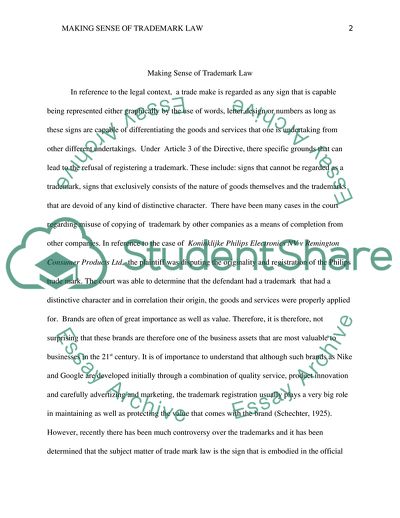Cite this document
(Making Sense of Trademark Law Essay Example | Topics and Well Written Essays - 2000 words, n.d.)
Making Sense of Trademark Law Essay Example | Topics and Well Written Essays - 2000 words. https://studentshare.org/law/1815391-the-subject-matter-of-trade-mark-law-has-come-to-be-the-sign-embodied-in-the-official-register-not-the-sign-as-applied-to-goods-in-the-marketplace-burrell-handler-making-sense-of-trade-mark-law
Making Sense of Trademark Law Essay Example | Topics and Well Written Essays - 2000 words. https://studentshare.org/law/1815391-the-subject-matter-of-trade-mark-law-has-come-to-be-the-sign-embodied-in-the-official-register-not-the-sign-as-applied-to-goods-in-the-marketplace-burrell-handler-making-sense-of-trade-mark-law
(Making Sense of Trademark Law Essay Example | Topics and Well Written Essays - 2000 Words)
Making Sense of Trademark Law Essay Example | Topics and Well Written Essays - 2000 Words. https://studentshare.org/law/1815391-the-subject-matter-of-trade-mark-law-has-come-to-be-the-sign-embodied-in-the-official-register-not-the-sign-as-applied-to-goods-in-the-marketplace-burrell-handler-making-sense-of-trade-mark-law.
Making Sense of Trademark Law Essay Example | Topics and Well Written Essays - 2000 Words. https://studentshare.org/law/1815391-the-subject-matter-of-trade-mark-law-has-come-to-be-the-sign-embodied-in-the-official-register-not-the-sign-as-applied-to-goods-in-the-marketplace-burrell-handler-making-sense-of-trade-mark-law.
“Making Sense of Trademark Law Essay Example | Topics and Well Written Essays - 2000 Words”. https://studentshare.org/law/1815391-the-subject-matter-of-trade-mark-law-has-come-to-be-the-sign-embodied-in-the-official-register-not-the-sign-as-applied-to-goods-in-the-marketplace-burrell-handler-making-sense-of-trade-mark-law.


